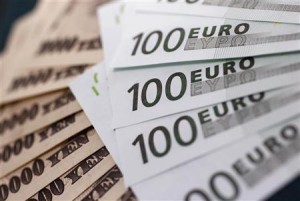 Friday’s trade saw EUR/JPY within the range of 133.51-135.92. The daily low has also been the lowest level since February 5th, when a low of 132.49 was recorded. The pair closed at 135.46, gaining 0.19% on a daily basis. The cross rose 0.18% for the whole week, which marked a fourth consecutive weekly gain. On Monday (February 23rd) EUR/JPY may be influenced by a number of fundamentals, as listed below.
Friday’s trade saw EUR/JPY within the range of 133.51-135.92. The daily low has also been the lowest level since February 5th, when a low of 132.49 was recorded. The pair closed at 135.46, gaining 0.19% on a daily basis. The cross rose 0.18% for the whole week, which marked a fourth consecutive weekly gain. On Monday (February 23rd) EUR/JPY may be influenced by a number of fundamentals, as listed below.
Fundamentals
Euro area
German IFO Business Climate Indicator
Business climate in Germany probably continued to improve in February, with the respective gauge rising to 107.7 from 106.7 in January. If so, this would be the highest index reading since July 2014, when the indicator came in at 108.0.
The IFO Business Climate Index reflects entrepreneurs’ sentiment in regard to current business situation and their expectations for the next six months. The index is based on a survey, conducted by phone and encompasses 7 000 companies, that operate in sectors such as manufacturing, construction, wholesaling and retailing industry. The Business Climate Balance represents the difference between the percentage share of respondents that are optimistic and the share of respondents that are pessimistic. The balance can fluctuate between -100, which suggests all responding companies assess their situation as poor and expect business conditions to deteriorate, and +100, which suggests all responding companies assess their situation as good and expect an improvement in business conditions. In order to calculate the IFO Business Climate Index, the Balance is normalized to the average of a base year, which currently is 2005.
The IFO Business Climate Index is comprised by two equally-weighted sub-indexes – a gauge of expectations and a gauge of current assessment. The IFO expectations index probably rose to 103.0 in February from 102.0 in January. If so, this would be the highest level since July 2014, when it was reported at 103.4. The IFO current assessment index probably advanced to 112.7 in the current month from 111.7 in January. If so, this would be the highest index value since July 2014, when the indicator stood at 112.9. In case any of the gauges registered a larger-than-projected increase, this might have a bullish effect on the single currency.
The CESifo Group is to release the official numbers at 9:00 GMT on Monday.
Japan
BoJ Minutes
At 23:50 GMT on Sunday the Bank of Japan will release the minutes from its meeting on policy, held on February 18th. The minutes offer detailed insights on the central bank’s monetary policy stance. This release is closely examined by traders, as it may provide clues over interest rate decisions in the future. Moderate-to-high volatility is usually present after the publication. In case the minutes show a hawkish outlook, this usually supports the yen, while a dovish outlook usually has a bearish effect on the national currency.
The Bank of Japan pledged that it would continue purchasing government bonds in order to boost monetary base at an annual pace of about JPY 80 trillion. The Policy Board also decided by an 8-1 vote to buy exchange-traded funds (ETFs) and Japan real estate investment trusts (J-REITs), so that their amounts outstanding will expand at an annual pace of about JPY 3 trillion and about JPY 90 billion respectively.
According to excerpts from the Bank of Japans most recent policy statement: ”With regard to the outlook, Japans economy is expected to continue its moderate recovery trend. The year-on-year rate of increase in the CPI is likely to slow for the time being, reflecting the decline in energy prices.”
”Quantitative and qualitative monetary easing (QQE) has been exerting its intended effects, and the Bank will continue with the QQE, aiming to achieve the price stability target of 2 percent, as long as it is necessary for maintaining that target in a stable manner. It will examine both upside and downside risks to economic activity and prices, and make adjustments as appropriate.”
Pivot Points
According to Binary Tribune’s daily analysis, the central pivot point for the pair is at 134.96. In case EUR/JPY manages to breach the first resistance level at 136.42, it will probably continue up to test 137.37. In case the second key resistance is broken, the pair will probably attempt to advance to 138.83.
If EUR/JPY manages to breach the first key support at 134.01, it will probably continue to slide and test 132.55. With this second key support broken, the movement to the downside will probably continue to 131.60.
The mid-Pivot levels for Monday are as follows: M1 – 132.08, M2 – 133.28, M3 – 134.49, M4 – 135.69, M5 – 136.90, M6 – 138.10.
In weekly terms, the central pivot point is at 135.08. The three key resistance levels are as follows: R1 – 136.66, R2 – 137.85, R3 – 139.43. The three key support levels are: S1 – 133.89, S2 – 132.31, S3 – 131.12.





